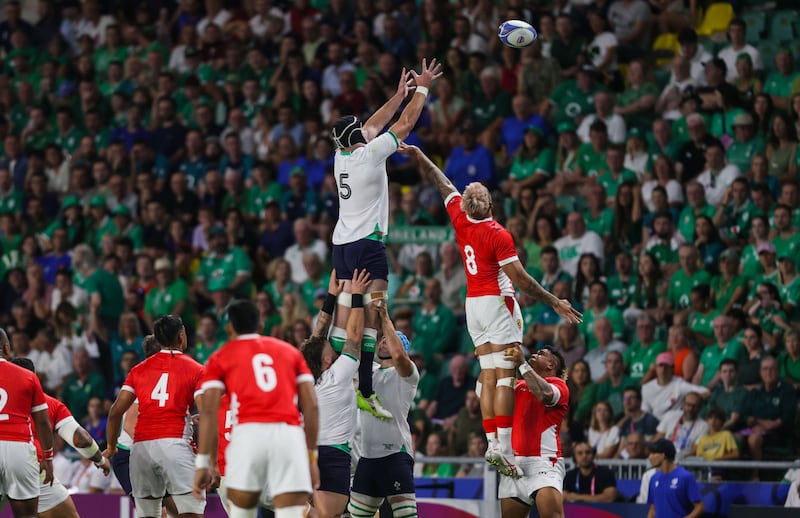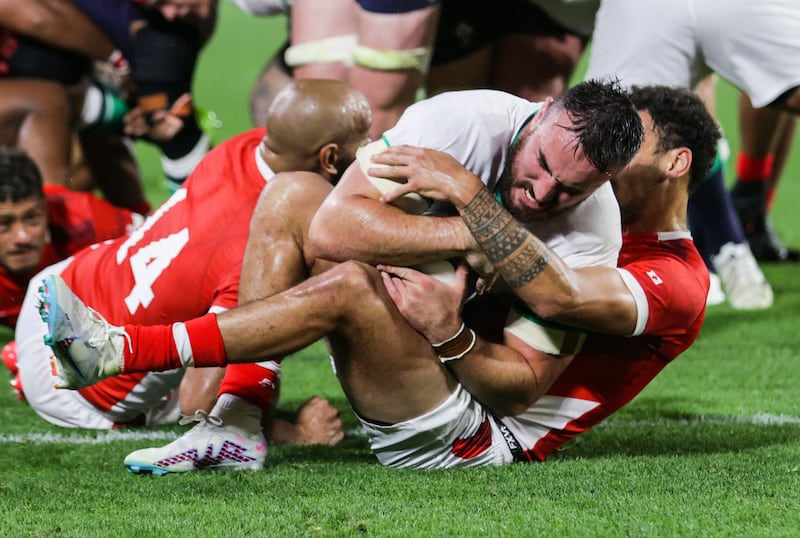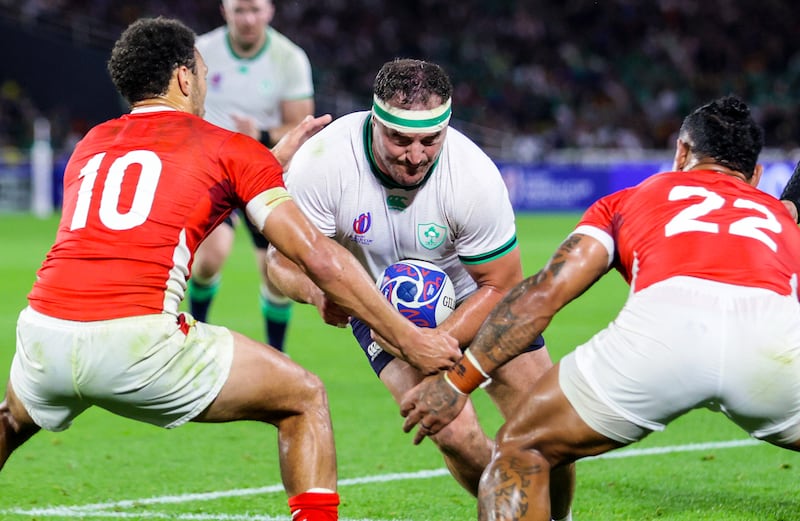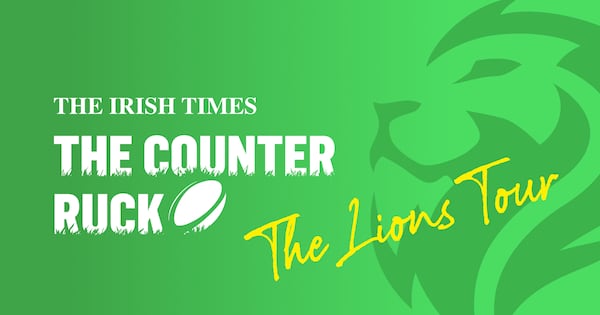The great American basketball coach John Wooden knew a thing or three about building successful teams and fostering a winning mentality among players. So his observation that “adversity is the state in which man becomes most easily acquainted with himself, being especially free of admirers then”, carries resonance for those who manage to swat aside career setbacks.
Ronan Kelleher’s performance against Tonga at the Stade de La Beaujoire was a reminder of what a fine rugby player he is when freed from the shackles of injury. There isn’t a bushel big enough to hide his talent but when tethered to a treatment table over a protracted period, others step into the breach, becoming the next shiny prospect. It is the nature of sport.
Shoulder and hamstring injuries tore asunder the 25-year-old’s playing opportunities over the last two years, curtailing his involvement with Leinster and Ireland. He started seven successive Test matches in the 2021-2022 season but then sustained a shoulder injury against France and didn’t play for Ireland again until the corresponding Six Nations fixture a year later.
That time has been a patchwork quilt of playing, including being called into the Lions squad in South Africa, and trying to escape the unrelenting frustration of injury, right up to missing the three World Cup warm-up matches with a hamstring problem.
READ MORE

In Kelleher’s periodic absences, Dan Sheehan came through with Leinster and Ireland while Ulster’s Rob Herring has been consistently excellent when called upon by Ireland in whatever capacity, starter or replacement, adding another brace of tries to his tally in the Tonga match.
It crystallises the necessity of maximising opportunity and that’s exactly what Kelleher did on Saturday night in Nantes. Ireland’s lineout has been a little scruffy of late, its component parts misfiring to the point that it was the least efficient (66.71 per cent) of all the teams in the opening round of fixtures at the World Cup.
Compare that to an 85.7 per cent success rate when Andy Farrell’s side won the Grand Slam earlier this year or a lineout running at 81.3 per cent across last month’s warm-up fixtures. A hooker is at the pointy end of the unit skill. As a rule of thumb expressed by those forwards who participate in the set piece, the solution is generally to tweak here and there. It’s a default explanation that leans on brevity rather than insight.

In the official match statistics Ireland had 21 lineout throws against Tonga and won 19, the two that went astray were from Herring late on in the match. Tonga rarely contested Irish ball but Peter O’Mahony, who was Ireland’s most prolific source with seven, was beaten to a touch on a ball at two that appeared to lack a little zip as he pitched down and forward to try and rescue it.
On Herring’s next delivery it looked like a lifting malfunction as the ball sailed over the green and the red massed ranks below. At that point Kelleher was safely ensconced in the stands, Ireland’s frontrow withdrawn en masse at half-time; Tadhg Furlong returned following Finlay Bealham’s head knock.
Ireland struggled to find their rhythm initially, a knock-on here, a scrum-free kick there but the lineout platform was rock solid, James Ryan the preferred choice early on. Kelleher’s effective carrying game was evident from the outset, released in the midfield as the principal buttress in a second-wave attack from a lineout launch play.
Tongans check for loose fillings in the tackle, especially for opponents who don’t use footwork and or bring a degree of subtlety to running lines, but there are occasions when a full-frontal collision can’t be avoided. Kelleher, and man-of-the-match Bundee Aki, excelled in heavy contact to ensure that their team-mates kept looking and moving forward.
[ Ireland v Tonga: Post-match team reactionOpens in new window ]
The two combined off another lineout with Kelleher hitting Aki on a cutback, on the next launch from the sideline Mack Hansen came off the blindside wing but the move withers with a ruck infringement. Kelleher remained at the centre of affairs as he adroitly fielded a high ball and the only time that the lineout threatened a misfire Josh van der Flier was sharpest to react to a loose ball.

He might have grabbed Ireland’s second try of the match but a lineout maul stalled heading towards the Tongan line. After a brief reorientation, Doris took over from Kelleher as tailgunner to score. Mack Hansen’s delightful matrix-like finish for his try understandably drew many admiring glances but its genesis can be traced to the impetus that Kelleher’s carry generated.
The hooker featured prominently in a tackling capacity in Ireland’s goal-line stand before the interval with O’Mahony in the sin bin, ultimately unsuccessful but that was more of an organisation than a commitment issue.
Kelleher said afterwards: “It was a really physical game but delighted we got through it and came out the right side of the result. It [the lineout] went well, it has been a work in progress over the last couple of weeks, little tweaks here and there but it was good to see it come to fruition tonight.”
There was so much more to his game. Ireland are very fortunate to possess three superb hookers and irrespective of whom Farrell plumps for against South Africa in the Stade de France, the team should be well served. Kelleher got his opportunity and took it and that is the most persuasive advocacy for retaining his place in the matchday number lotto; 2 or 16.















